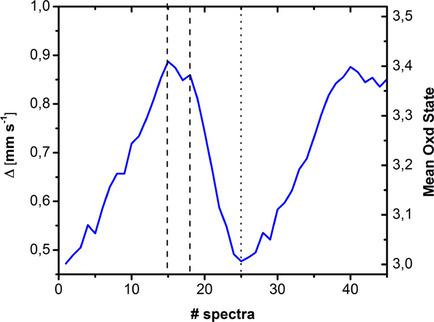当前位置:
X-MOL 学术
›
Batteries Supercaps
›
论文详情
Our official English website, www.x-mol.net, welcomes your feedback! (Note: you will need to create a separate account there.)
The Fe4+/3+ Redox Mechanism in NaFeO2: A Simultaneous Operando Nuclear Resonance and X‐ray Scattering Study
Batteries & Supercaps ( IF 5.7 ) Pub Date : 2020-08-05 , DOI: 10.1002/batt.202000157 Marcus Fehse 1, 2, 3 , Dimitrios Bessas 4 , Abdelfattah Mahmoud 5, 6 , Aliou Diatta 7, 8 , Raphael P. Hermann 6, 9 , Lorenzo Stievano 3, 7, 8 , Moulay Tahar Sougrati 7, 8
Batteries & Supercaps ( IF 5.7 ) Pub Date : 2020-08-05 , DOI: 10.1002/batt.202000157 Marcus Fehse 1, 2, 3 , Dimitrios Bessas 4 , Abdelfattah Mahmoud 5, 6 , Aliou Diatta 7, 8 , Raphael P. Hermann 6, 9 , Lorenzo Stievano 3, 7, 8 , Moulay Tahar Sougrati 7, 8
Affiliation

|
Simultaneous operando Nuclear Forward Scattering and transmission X‐ray diffraction and 57Fe Mössbauer spectroscopy measurements were carried out in order to investigate the electrochemical mechanism of NaFeO2 vs. Na metal using a specifically designed in situ cell. The obtained data were analysed using an alternative and innovative data analysis approach based on chemometric tools such as Principal Component Analysis (PCA) and Multivariate Curve Resolution ‐ Alternating Least Squares (MCR‐ALS). This approach, which allows the unbiased extraction of all possible information from the operando data, enabled the stepwise reconstruction of the independent “real” components permitting the description of the desodiation mechanism of NaFeO2. This wealth of information allows a clear description of the electrochemical reaction at the redox‐active iron centres, and thus an improved comprehension of the cycling mechanisms of this material vs. sodium.
中文翻译:

NaFeO2中Fe4 + / 3 +的氧化还原机理:同时进行的核磁共振和X射线散射研究
为了研究NaFeO 2相对于Na金属的电化学机理,采用了专门设计的原位电池,同时进行了核磁共振正向散射和透射X射线衍射以及57 FeMössbauer光谱测量。使用基于化学计量工具(例如主成分分析(PCA)和多变量曲线分辨率-最小二乘法(MCR-ALS))的替代性创新数据分析方法对获得的数据进行分析。这种方法,它允许对所有可能的信息的公正提取从operando数据可以逐步重建独立的“真实”成分,从而可以描述NaFeO 2的脱氧机理。大量的信息可以清楚地描述氧化还原活性铁中心的电化学反应,因此可以更好地理解这种材料相对于钠的循环机理。
更新日期:2020-08-05
中文翻译:

NaFeO2中Fe4 + / 3 +的氧化还原机理:同时进行的核磁共振和X射线散射研究
为了研究NaFeO 2相对于Na金属的电化学机理,采用了专门设计的原位电池,同时进行了核磁共振正向散射和透射X射线衍射以及57 FeMössbauer光谱测量。使用基于化学计量工具(例如主成分分析(PCA)和多变量曲线分辨率-最小二乘法(MCR-ALS))的替代性创新数据分析方法对获得的数据进行分析。这种方法,它允许对所有可能的信息的公正提取从operando数据可以逐步重建独立的“真实”成分,从而可以描述NaFeO 2的脱氧机理。大量的信息可以清楚地描述氧化还原活性铁中心的电化学反应,因此可以更好地理解这种材料相对于钠的循环机理。



























 京公网安备 11010802027423号
京公网安备 11010802027423号